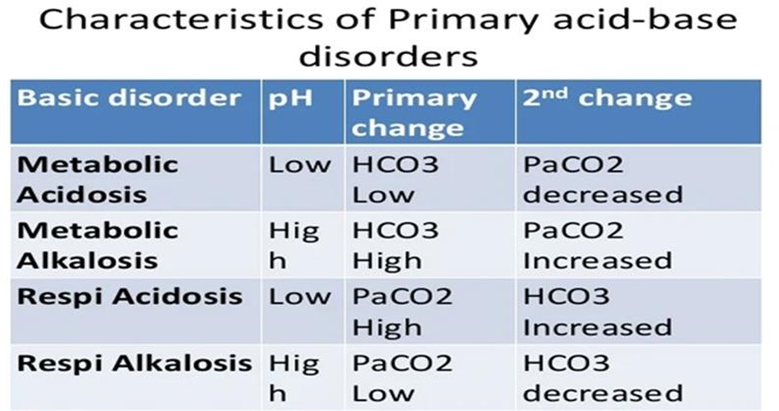A client is admitted to the medical-surgical unit with a chief complaint of prolonged vomiting over the past 24 hours. Based on the arterial blood gas (ABG) results of pH 7.5. PaCO2 36, HCO3 40, the nurse determines that the client is experiencing:
respiratory alkalosis.
respiratory acidosis.
metabolic acidosis.
metabolic alkalosis.
The Correct Answer is D
D. Metabolic alkalosis is characterized by an increased pH (alkalosis) and an increased HCO3. In this case, the pH is elevated (7.5), indicating alkalosis, which supports metabolic alkalosis. The HCO3 is elevated at 40 mEq/L, which further supports metabolic alkalosis. The PaCO2 is normal or slightly low (36 mmHg), which can occur as a compensatory response to metabolic alkalosis.

A. Respiratory alkalosis is characterized by an increase in pH (alkalosis) and a decrease in PaCO2 (hypocapnia). In this scenario, the pH is elevated (7.5), which indicates alkalosis. The PaCO2 is 36 mmHg, which is within the normal range (35-45 mmHg) but slightly on the lower side (slight hypocapnia). The HCO3 is elevated at 40 mEq/L, which suggests a compensatory response by the kidneys to retain bicarbonate to counteract the alkalosis.
B. Respiratory acidosis is characterized by a decrease in pH (acidosis) and an increase in PaCO2 (hypercapnia). In this case, the pH is elevated (7.5), indicating alkalosis, which contradicts respiratory acidosis. The PaCO2 is 36 mmHg, which is normal or slightly low, not high as expected in respiratory acidosis. The elevated HCO3 (40 mEq/L) suggests a compensatory metabolic response to the alkalosis, not to acidosis.
C. Metabolic acidosis is characterized by a decreased pH (acidosis) and a decreased HCO3. In this scenario, the pH is elevated (7.5), indicating alkalosis, which contradicts metabolic acidosis. The HCO3 is elevated at 40 mEq/L, indicating metabolic alkalosis rather than metabolic acidosis.
Nursing Test Bank
Naxlex Comprehensive Predictor Exams
Related Questions
Correct Answer is B
Explanation
B. This question is also inclusive as it does not assume the client's sexual orientation or relationship status. It allows the client to disclose their current relationship status, whether they are in a relationship with a partner of the same or different gender, or if they are single.
A. This question uses assumes the client's gender and sexual orientation.
C. This question assumes a heterosexual relationship and also implies traditional gender roles. It may not be inclusive as it assumes that the client has a wife and further stereotypes the role of a wife as a cook.
D. This question assumes a heterosexual relationship and may not be inclusive of clients who do not have husbands or who are in same-sex relationships. It also reinforces traditional gender roles by assuming that a husband is the primary breadwinner or has a defined occupation.
Correct Answer is ["A","B","E"]
Explanation
A. This is located on the lateral side of the thigh. It is a commonly used site for infants, toddlers, and young children, as well as adults who require large-volume injections.

B. This site is located on the hip or gluteal region. It is considered one of the safest and least painful sites for intramuscular injections in adults. It is also used when the volume of medication is larger or when the dorsogluteal site is contraindicated.
E. This site is located on the upper arm, specifically the lateral aspect. It is commonly used for vaccines and medications that require smaller volumes in adults and older children.
C. There is no specific muscle called the "rectus lateralis." It seems to be a combination of the rectus femoris (a muscle in the quadriceps group of the thigh) and the vastus lateralis. However, neither "rectus lateralis" nor "rectus femoris" is commonly used as a distinct injection site in clinical practice.
D. This site is located on the buttocks. Historically, it was a commonly used site for intramuscular injections, but it has fallen out of favor due to the potential risk of injury to the sciatic nerve and superior gluteal artery.
Whether you are a student looking to ace your exams or a practicing nurse seeking to enhance your expertise , our nursing education contents will empower you with the confidence and competence to make a difference in the lives of patients and become a respected leader in the healthcare field.
Visit Naxlex, invest in your future and unlock endless possibilities with our unparalleled nursing education contents today
Report Wrong Answer on the Current Question
Do you disagree with the answer? If yes, what is your expected answer? Explain.
Kindly be descriptive with the issue you are facing.
